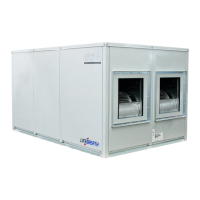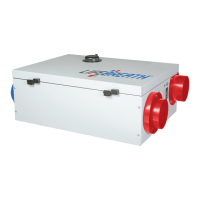Do you have a question about the Lifebreath 350DCS and is the answer not in the manual?
Consider careful installation to avoid backdrafting or improper functioning of vented combustion equipment.
Do not apply electrical power to the unit until installation has been fully completed, including low voltage wiring.
Details net supply airflow, effectiveness, and temperature effectiveness against external static pressure.
Lists available Lifebreath digital and ventilation controls like DXPL02, BC02, BC03, BC04, and DH01.
Details available timer options including wired and wireless models like DET01, DET02, and RX02.
Defines terms like Defrost Mode, Dehumidistat, Recirculation, Self Test, Standby Mode, and Ventilation.
Discusses how much ventilation is needed based on building occupancy, construction, and personal preference.
Explains continuous operation for normal use and high-speed during increased activity.
Covers modes like 20/40 Recirculation, 20/40 Standby, and 10/50 Standby for reduced ventilation.
Details continuous recirculation and continuous low/high fan speed operation.
Highlights key features like 5-speed fan, dehumidistat, wireless compatibility, and selectable modes.
Guides on turning on, setting speed, using the 20/40/60 button, and selecting operational modes.
Outlines features like 2-speed fan, standby setting, dehumidistat, and wireless timer compatibility.
Details on turning on, setting speed, humidity control, and adjusting the dehumidistat.
Lists key features including continuous low speed, dehumidistat, 3 modes, and wireless timer compatibility.
Explains operation for humidity control, dehumidistat, 20/40 mode, and recirculation mode.
Features include 2-speed fan, standby, 20/40 mode, and wireless timer compatibility.
Guides on turning on, setting speed, and operating the 20/40 mode.
Explains how the dehumidistat reduces indoor humidity by initiating high-speed ventilation.
Provides notes on when to use the dehumidistat and conditions for its activation/deactivation.
Details its function to measure humidity and initiate high-speed ventilation when levels exceed the set point.
Guides on setting the desired humidity level and interpreting indicator lights.
Step-by-step guide for installing the DXPL02 main control, including faceplate separation and wiring.
Instructions for installing BC02, BC03, or BC04 controls, including mounting and wiring.
Provides instructions for installing the DH01 on a flush or surface mount, including wiring and mounting.
Guides on mounting the wireless timer, pairing it with controls, and extending range with a repeater.
Describes how to use the wired timer for high-speed ventilation overrides and lockout mode.
Details on operating the timer for high-speed ventilation, moving it, and replacing the battery.
Explains the role of the repeater in extending the wireless timer's range and its operational indicators.
Details wiring connections for the 2-wire mechanical timer to the HRV terminal block.
Explains how to interlock the HRV with an air handler/furnace blower for synchronized operation.
Describes how to configure the HRV for standby operation instead of full off, using jumpers or main control settings.
Details how to operate the HRV using dry contacts for low speed, high speed, and dehumidistat functions.
Specifies requirements for mounting the HRV in a heated space, ensuring level installation and service clearance.
Provides guidance on designing ductwork for maximum efficiency, minimizing elbows, and using insulated ducting.
Details requirements for weatherhoods, including bird screens, placement, and sealing.
Explains drawing air from points of poor quality and balancing dampers.
Details connecting the supply duct to the return air duct or separate systems, and codes.
Lists available Techgrille models for supply air diffusers and exhaust covers.
Shows how the HRV integrates with rooftop units, providing fresh air to return plenums or ceiling spaces.
Warns about ensuring correct fan rotation when interlocking rooftop units with HRV/ERVs.
Provides instructions for connecting the drain spout, creating a P-trap, and ensuring proper water seal.
Specifies the required downward slope for the drain trap and tubing to prevent issues.
Explains using a pitot tube and manometer to balance airflow for maximum efficiency.
Details how to determine airflow by multiplying velocity pressure readings by duct cross-sectional area.
Guides on accessing and servicing the PSC motor, noting its sleeve mechanism.
Provides instructions for accessing and cleaning the heat exchange core, noting its sharp edges.
Instructions for accessing, removing, washing, and maintaining the supply and exhaust air filters.
Details on cleaning condensate drain pans and lines, checking for blockages, and preventing bacterial growth.
Recommends inspecting ductwork, weatherhoods, and lubricating damper motor shafts periodically.
Advice on wiping down the cabinet interior to remove dust and cobwebs as part of routine maintenance.
Presents the overall wiring diagram for the unit, including fan motors, transformers, and control connections.
Provides specific wiring details for fan motors, auto-transformer, and defrost components.
Outlines the 2-year limited warranty and 15-year HRV core warranty, including exclusions and repair procedures.
Details how to contact AIRIA BRANDS INC. for warranty service and options for labour costs.
| Brand | Lifebreath |
|---|---|
| Model | 350DCS |
| Category | Heating System |
| Language | English |












